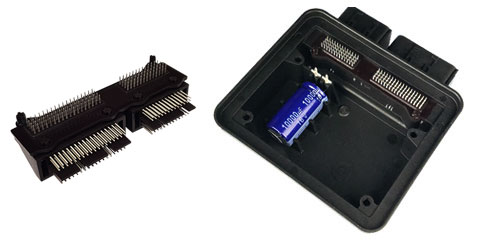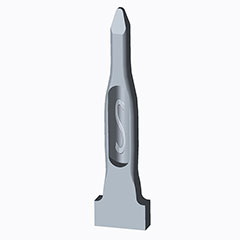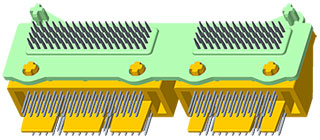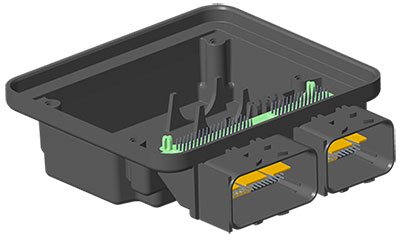Overview
The global automotive industry is undergoing sweeping transformation as a result of trends such as the electrification of drivetrains, integration of advanced infotainment functions, and the emergence of autonomous self-driving vehicles. In addition to radically altering the competitive forces in the market, these trends also create significant new challenges for designers of automotive systems and components.
Technological issues commonly faced by engineers include:
1. Higher circuit densities,
2. Higher pin counts,
3. Integrated power applications, and
4. Critical importance of signal integrity for vital mobility, safety and autonomous driving functions.
Unsurprisingly, efficiently integrating key functions throughout the vehicle with Electronic Control Units (ECUs) has also become a critical factor for success. New-gen vehicles can have many embedded ECUs to handle key functions, such as Engine Control Module, Brake Control Module, Transmission Control Module, Central Timing Module, Suspension Control Module, Speed Control Unit, Battery Management System, Telematic Control Unit, and so on. In some cases, the ECUs could also integrate multiple sub-functions— exemplified by the Powertrain Control Module that controls and integrates engine, transmission, speed and other related functions.
Behind the scenes, these challenges are rapidly transforming the design and integration of compact, reliable and cost-effective interconnects between ECUs and key subsystems, as well as between various modules within modern vehicles.

Press-Fit Technology Innovations Enable New Design Approaches
Building on a long-standing history of proven performance in automotive applications, the reach of Press-Fit technology is now being extended with new innovative approaches to address the challenges described above for higher circuit densities, pin counts and the flexibility to integrate directly into complex automotive modules.
Press-Fit’s ability to eliminate soldering hassles while providing high-reliability interconnects with excellent thermal characteristics, high current-carrying capacity and configuration flexibility are valuable characteristics that make the technology a good fit for stringent automotive requirements.
As discussed in the following sections, the new smaller Press-Fit configurations support higher densities and tighter spacing of pins, while innovative connector pre-mold technology streamlines manufacturing, simplifies required sealing methods and, with integrated Press-Fit technology, lowers costs and improves reliability.

Smaller Hybrid Design Press-Fit Interconnects Enable Higher Densities
ENNOVI’s MiniPLX Press-Fit builds on the proven eye-of-the-needle Press-Fit technology within a new hybrid design that delivers higher density interconnect solutions, while also expanding the configuration options available to product engineers.

Its hybrid design combines the best of 2 styles of Press-Fit technology: the strength and retention of a web-based design, together with the assembly advantages of proven eye-of-the needle designs.
The MiniPLX is designed to accommodate usage in a variety of connector design applications. It can be packaged as separate individual pins in a reeled format or on stamped strips. The latter delivers the pins in a continuous-stamped configuration that can be used in the automated assembly of multi-pin connector arrays. This gives designers the flexibility to create virtually any pin-out configuration (e.g. number of pins, rows, spacing, etc.) that is required by their specific end application.
Pre-Molded Biscuit Press-Fit Header Approach
From an assembly standpoint, new innovations in pre-molding with integrated Press-Fit interconnects not only simplify production steps and lower costs for high-density modules, but also improve overall product performance reliability.
The pre-molded biscuit design encompasses a biscuit sub-assembly of precisely located Press-Fit interconnects in various sizes and styles to form the specified pin-out array. The proprietary pre-molding process maintains pin locations and integrity while flowing plastic around the pin fields to lock the pins in position, thereby preventing any movement during subsequent assembly and molding processes.

The pre-molded biscuit also includes interlock features to maintain tight GD&T positional tolerances for both connector & Printed Circuit Board (PCB) interfaces. It ensures that precise location of the biscuit and proper alignment of pins within the connector shroud is maintained when the ECU enclosure is overmolded around the biscuit. This combination of pre-molding and interlock positioning holds critical features in place during this overmolding process and the ensuing PCB assembly step. The overall process is optimized to create a reliable sealed ECU module and provides support for reaction forces during subsequent Press-Fit to PCB assembly.
This ECU module connector is designed to provide a high level of configuration flexibility with options for multiple rows and various pin spacing requirements. By implementing the custom connector pin array in the pre-molded biscuit sub-assembly, final assembly and molding processes are simplified while also maintaining precise pin alignment and assuring high structural integrity of the completed ECU module.

Summary
As the advent of electric-drive vehicles, autonomous self-driving capabilities and proliferation of other new automotive applications spurs the need for higher circuit densities and widening range of ECU module requirements, the evolution of proven Press-Fit technology is keeping pace.
New Press-Fit products such as the MiniPLX hybrid design are enabling tighter pin spacing, while the innovative use of pre-molded biscuit arrays allows Press-Fit interconnects to be configured into highly reliable and robust subassemblies for use in overmolded ECU modules.
The combined benefits of these innovations enable automotive designers and process engineers to accommodate the widening requirements for custom ECU modules to support new and progressive automotive applications.
For More Information
For additional details about Press-Fit, explore our Press-Fit webpage. To enquire about our automotive products, drop us an email at communications@ennovi.com.
